Everything you need to know about the history and traditions surrounding the Opening of the Academic Year
| Date: | 02 September 2024 |
| Author: | Hylke |
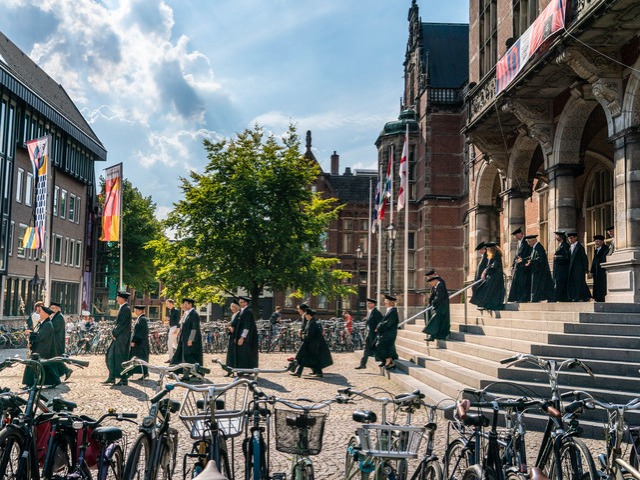
Today is the Opening of the Academic Year! In light of this, we have interviewed beadle Mr Lunsing Cazemier and organiser Mrs Monique Peperkamp who play very special roles in the event. They explain what they do, what their (historical) functions entail, and talk about the interesting history and traditions surrounding the yearly Opening Ceremony. Some of these facts might surprise you! ;)
We will start with Mr Cazemier whom we asked some questions about his historical function and the procession of professors as he will be the one who leads them to the Martini church this year.
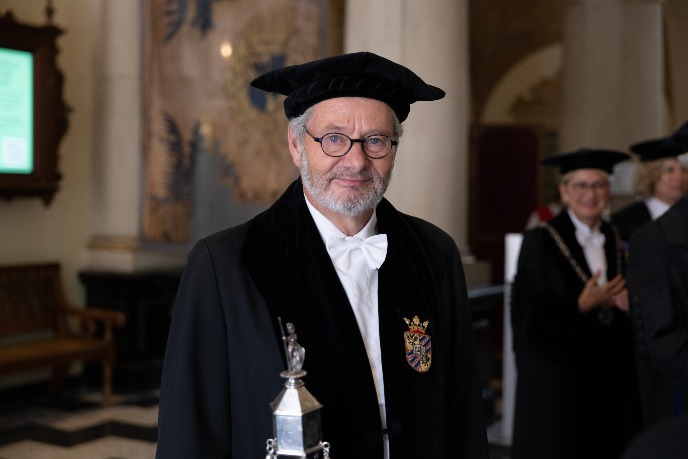
Could you briefly introduce yourself? Who are you and what is your role in the Opening Academic Year?
“I am Lunsing Cazemier, a pedel [beadle] at the University of Groningen. I have worked at the University Library for 29 years, before being asked to work as beadle at the Academy Building for which I had to officially apply. In order to become a beadle, I had to know the ins and outs of the function which I learned by accompanying a beadle as a hulppedel [help-beadle] for at least half a year. Once I knew everything there was to know, I officially became a beadle and could lead promotions and inaugural lectures which I have done for five years now. This year, during the Opening of the Academic Year, I will be in front of the cortège together with colleague Harry Oosterhuis to lead the procession to the Martini church and to oversee the ceremony, which is an honour. I love doing this work because it’s very rewarding. No day is the same.”

Could you explain what the function of beadle entails?
“The function was created in 1614 when the University was created. During the old days, the beadle’s main function was to lead the procession with a ceremonial staff. Occasionally, if people were in the way or out of line, the beadle could hit them with the bottom of the staff - as there’s a knob at the bottom - so the procession could continue smoothly. Over the years, the beadle stopped reprimanding people with their staff and their ceremonial functions broadened by overseeing promotions and inaugural lectures as well. Nevertheless, the beadle’s inherent function remained the same.”
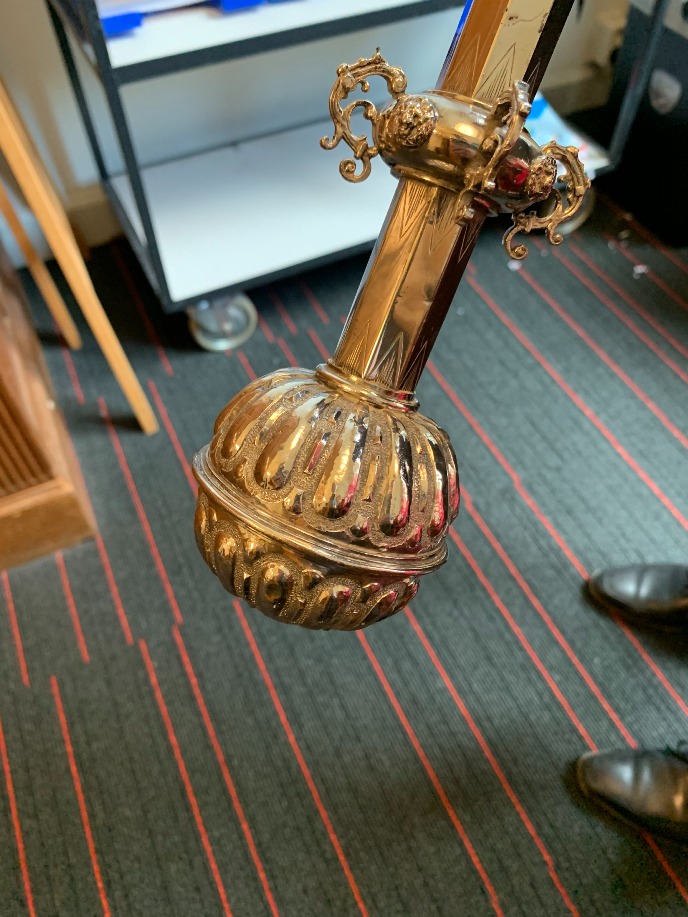
“Inherently, we are the master of ceremonies who keeps an eye on everything. For example, we make sure that speeches are contained within the time during promotions and inaugural lectures, that the right diplomas are present, that everyone has a glass of water, that the rows of chairs in the Aula are all straight, that microphones for the livestream have been turned on, that invitees are led to the right room for the reception afterwards, and so on. But we also make sure that candidates are correctly promoted to doctor because sometimes the promotor [a full professor of a university who acts as the principal supervisor of a student’s doctoral research] is so enthusiastic about the promotion that they forget half of the speech. My colleagues and I, then, remind them of what they have to say because otherwise the promotion is not valid. So, it’s a very important function.”
“Being beadle also comes with a lovely community and, once a year, we have a beadle-day where all beadles of the Netherlands come together to connect with each other, share experiences and do nice activities together. For example, the last time it was organised in Groningen, they did a cruise on the canals. Next year it will be in Groningen again, because we have a lustrum. I am looking forward to it!”
As you said before, you will lead the cortège this year, but what is a cortège exactly? And is there a specific line-up?
“The cortège is the procession of hoogleraren [professors] led by one or two beadles towards the Martini church, which always happens during the Opening of the Academic Year. The cortège consists of two parts: the burger cortège and the cortège. The burger cortège consists of the University’s Board with their invitees such as guest speakers. When the cortège arrives at the Martini church, the burger cortège are waiting outside to greet everyone because they do not walk in the procession. In front of the cortège, there is a procession of all the student organisations in Groningen which are led by a help-beadle. Harry and I will walk a little bit behind them leading the cortège of professors - we will only know how many professors there will be on the day itself. When we arrive, the burger cortège will go inside first and afterwards everyone else of the procession will go inside. Everyone has a specific spot as well, so when each person is inside I will say, “Please take your seats”, and the Opening Ceremony will start with a speech from the Rector Magnificus.”
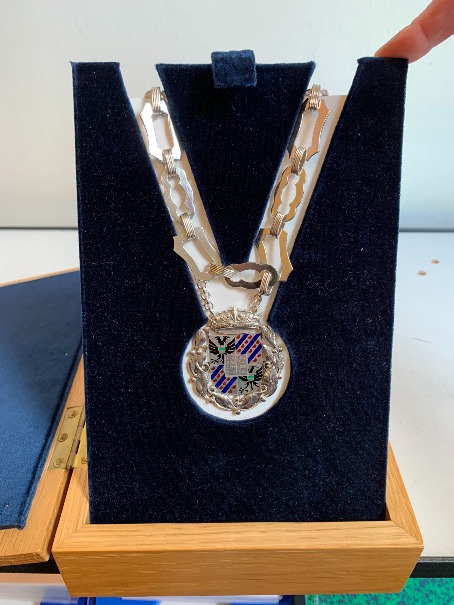
“I have to do something special as well during the Ceremony. Because Jacquelien Scherpen will be our new rector, I have to do a kete [necklace] exchange. That means that I will unclip the silver kete of the current Rector Magnificus Cisca Wijmenga and put it around Jacquelien Scherpen to signify the change of rectors. I’m excited for it!”
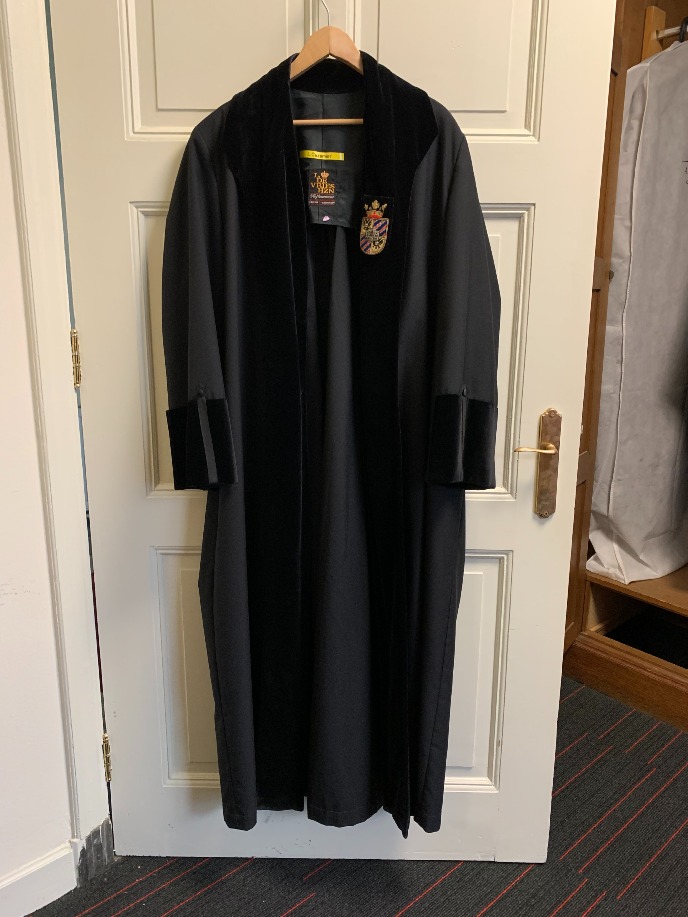
Why does everyone wear a toga [robe]? And does everyone wear the same toga?
“It shows your function and that you are an important person of the University. That is why beadles wear different togas than, for instance, professors or the Rector Magnificus. The toga of the beadle contains some velvet on the sleeves and has the emblem of the University embroidered on it whereas the toga of the professors does not have this but instead has buttons on the sleeves. As I will lead the cortège, I will also carry the ceremonial staff that has Minerva on top of it with little bells together with a knob at the bottom. I can ring these bells to, for example, let a speaker know that their time is up during a laudatio [a speech of praise often given during promotions] as this may only take six minutes. Or, I ring the bells to get the attention of the rector, for example, when everyone needs to stand so that she can ask them to stand. This is because the rector has the lead during the ceremony, promotion or inaugural lecture. We, as beadles, only make sure that everything runs smoothly.”
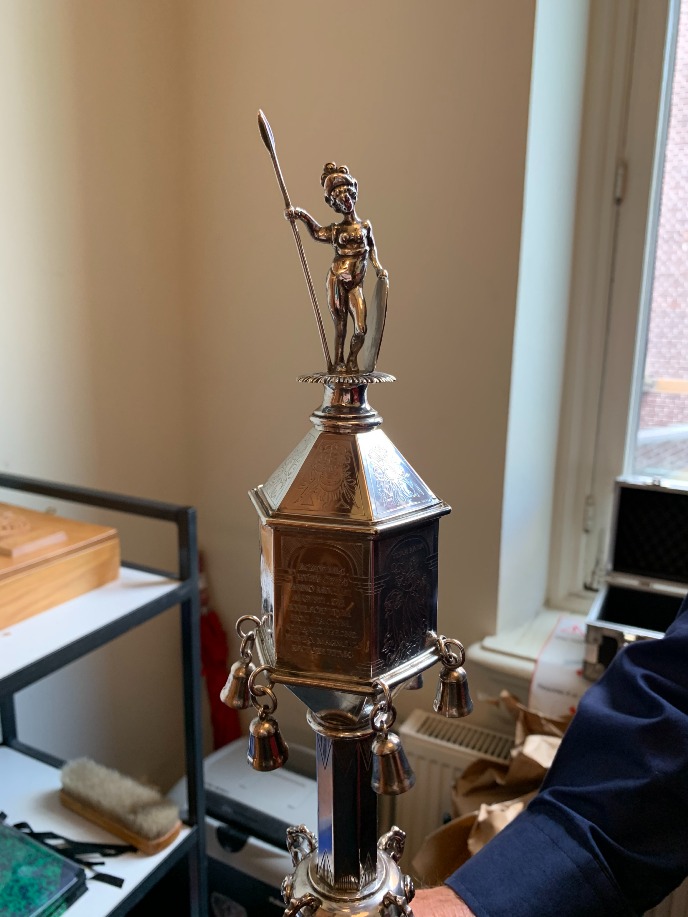
What are the rituals and traditions surrounding the toga?
“There are a lot of traditions surrounding the toga. For instance, at every event that we are present, the beadle wears their toga and the help-beadle wears a costume consisting of a white blouse underneath a dark coloured colbert, a red tie, dark trousers and dark shoes. We always wear dark trousers and dark shoes underneath the toga just as the professors. If someone does not wear dark shoes, for instance, we remind them that they have to wear them next time because this is also part of our job.”
“Every beadle, Rector Magnificus, and professor has their own toga. Newcomers can either choose to have a new toga made for them, for which they have to pay for themselves. They can also choose to use an old toga donated to the University by the family of a former professor or beadle, which is more sustainable. Most of the togas are being kept in closets in the faculty rooms at the Academy Building for which a professor can reserve a spot. Each of them has a specific number so they can easily be found. However, sometimes, someone grabs a toga that does not belong to them and does not place it back in the same spot. We then have to look for the toga. Some professors also like to store their togas at home.”
“Professors own their toga for life, so when they pass away we have to contact their family to ask what we can do with it. Some families would like the toga to be send to them as a token of remembrance. Other families would like to donate it to the University so it can be reused. This year, we found six togas of people who have passed away for years, so, before we can remove them, we have to contact their family to see what we may do with them.”
“Another tradition concerns the cleaning of the togas. Newcomers have to collect the toga poeder [toga powder] with which the togas are cleaned. Moreover, every summer holiday, the togas are brought to the cleaner’s so that they are nice and fresh for the Opening of the Academic Year. The silver kete of the Rector Magnificus and the silver on the staff are also cleaned then, which is done by a special silver smith here in Groningen. That silversmith also repairs the silver if something is damaged and has made the kete and silver details on the staff, which is very special!”
Now that we have learned more about the elements of and traditions surrounding the procession of the professors, and the historical function of beadle fulfilled by Mr Cazemier, let’s move on to the Opening Ceremony itself. Monique Peperkamp has an important role in the organisation of the event and can therefore tell us about the old and new elements of the ceremony.
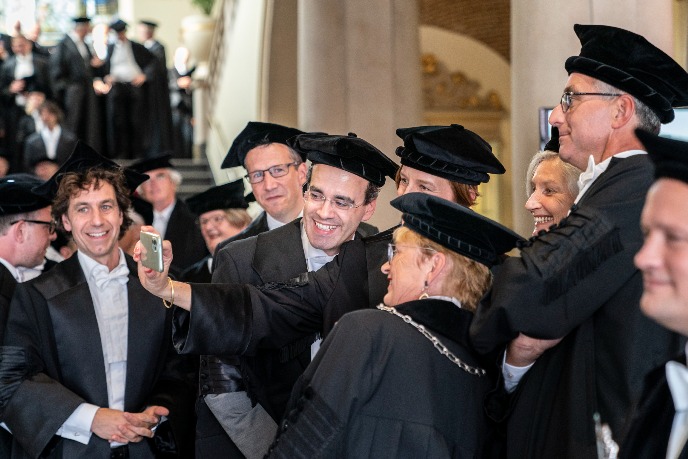
Could you briefly introduce yourself? Who are you and what is your role in the preparation of/during the ceremony?
“I am Monique Peperkamp, one of the head organisers of the Opening of the Academic year. I play a role in planning, organising and executing this yearly event. I am the contact person for guest speakers, the University’s Board, professors, external suppliers, external location, musicians, and so on. But also for internal departments who contribute to the ceremony such as the Communications department, AV Services, CIT, beadles, catering, the student assessor of the Board and other colleagues. Together with my colleagues, I take care of the programme’s line-up, the various invitations and that they are sent out. We also process the applications for the event, take care of the arrangement within the Martini church, the placement of guests, and the receptions, and so on.”
“Besides these duties, I also play a role in the organisation of the cortège and the procession of student organisations. Within the church, I make sure that the guests, speakers, VIPs, professors, and student organisations are rightly seated, and that the people who play a content-related role in the ceremony know what is expected of them. Moreover, just as Mr Cazemier, I make sure that everything runs smoothly and according to plan during the ceremony. That is a very exciting and nerve-racking experience!”
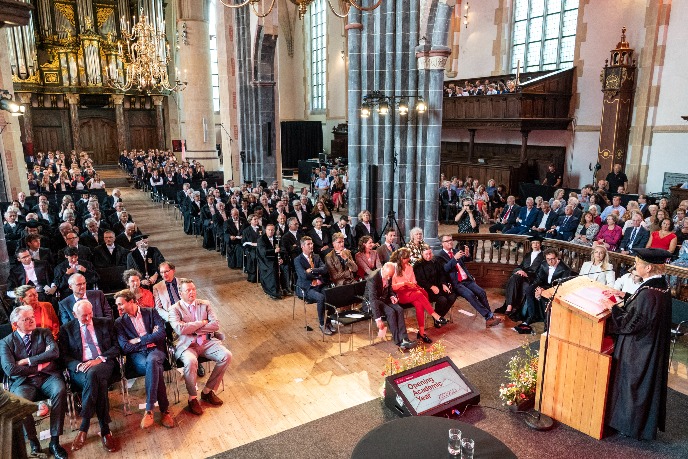
Can you explain how the Opening Ceremony goes? Are there fixed elements?
“There are many fixed elements in the Opening Ceremony. For example, the ceremony always starts with the academic walk from the Academy Building to the Martini church with professors and student and study associations with flags and banners, preceded by the beadles - Lunsing Cazemier and Harry Oosterhuis this year - with the staff. Within the church, the placing of professors, speakers, student and study associations, and VIPs is fixed. The content of the ceremony also contains some fixed elements such as an academic speech from one of our academics, an opening speech and closing speech by the Rector Magnificus, a student speaker, the new poet in residence declares a poem, and, lately, the Alumnus of the Year award. During the ceremony, there are musical interludes, organ playing and church carillon playing. Afterwards, there’s always the reception with drinks and bites.”
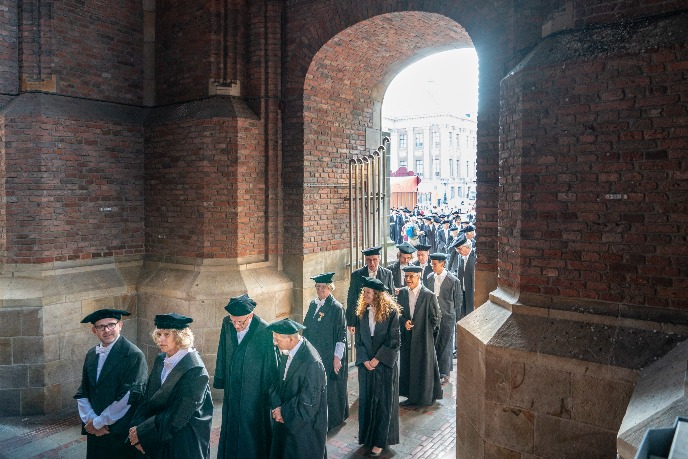
Are there very old elements in the Opening Ceremony? And are there elements that have been added recently?
“The academic walk of professors and students is a very old academic tradition. Professors wear their gowns and berets, and the students carry flags and banners of their associations. Most of the content I mentioned in the previous question is part of a long tradition as well, although it varies a bit from year to year. Recently, we added new content like debates and videos to make the ceremony more fun to watch because, nowadays, the ceremony is always live streamed and available for everyone to watch at home or at work.”
Do you have a favourite element or tradition concerning the ceremony?
“The ceremony is always very festive, dignified and special, and it always makes me feel proud to be part of the UG-community. I find the reception afterwards very pleasant and informal, when all guests (students, professors, colleagues, speakers and special guests) can meet and have a drink together. This year will be a special occasion because of the farewell of the current Rector Magnificus Prof Cisca Wijmenga and the formal installation of the new rector Prof Jacquelien Scherpen during the Opening Ceremony.”
Hopefully you’ve enjoyed learning more about the old and new elements of the Opening of the Academic Year and some of the important (historical) roles that come with it. Let us know which fact surprised you the most in the comments!
About the author

Hiya! :) I’m Hylke, a Dutch MA English Literature student. People often ask me if I’m Frisian, but sadly I’m not; I just have a Frisian name. I love reading, writing, meeting with friends, and the colour yellow, so much so that I take pictures of every yellow wall I can find!

